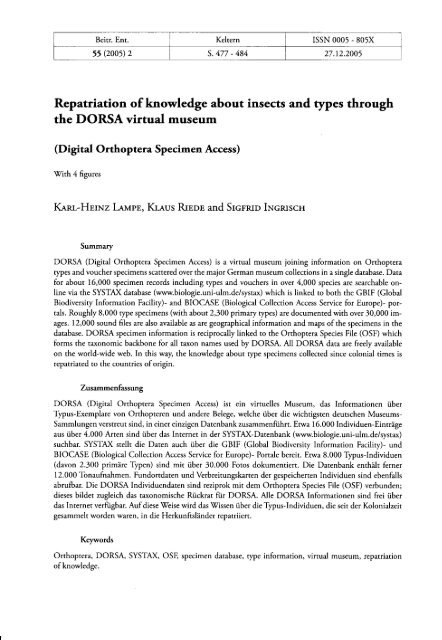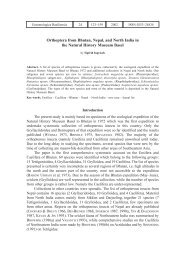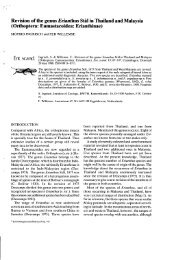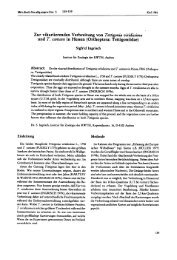the DORSA virtual museum - Sigfrid Ingrisch
the DORSA virtual museum - Sigfrid Ingrisch
the DORSA virtual museum - Sigfrid Ingrisch
Create successful ePaper yourself
Turn your PDF publications into a flip-book with our unique Google optimized e-Paper software.
Beitr. Ent. Kelrern ISSN 0005 - 805X55 (2005) 2 s.477 - 484 27.12.2005Repatriation of knowledge about insects and types through<strong>the</strong> <strong>DORSA</strong> <strong>virtual</strong> <strong>museum</strong>(Digital Orthoptera Specimen Access)With 4 figuresKanr-HBrNzLeupB,Kraus RnoB and Srcrnro INcnrscHSummary<strong>DORSA</strong> (Digital Orthoptera Specimen Access) is a <strong>virtual</strong> <strong>museum</strong> joining information on Orthopteratypes and voucher specimenscattered over <strong>the</strong> major German <strong>museum</strong> collections in a single database. Datafor about 16,000 specimen records including types and vouchers in over 4,000 species are searchable onlinevia <strong>the</strong> SYSTAX database (www.biologie.uni-ulm.de/systax) which is linked to both <strong>the</strong> GBIF (GlobalBiodiversiry Information Facility)- and BIOCASE (Biologicd Collection Access Service for Europe)- portals.Roughly 8,000 rype specimens (with about 2,300 primary types) are documented with over 30,000 images.12,000 sound files are also available as are geographical information and maps of <strong>the</strong> specimens in <strong>the</strong>database. <strong>DORSA</strong> specimen information is reciprocally linked to <strong>the</strong> Orthoptera Species File (OSF) whichforms <strong>the</strong> taxonomic backbone for all taxon names used by <strong>DORSA</strong>. All <strong>DORSA</strong> data are freely availableon <strong>the</strong> world-wide web. In this way, <strong>the</strong> knowledge about type specimens collected since colonial times isrepatriated to <strong>the</strong> countries oforigin.Zusammenfassung<strong>DORSA</strong> (Digital Orthoptera Specimen Access) ist ein virtuelles Museum, das Informationen iiberTypus-Exemplare von Orthopteren und andere Belege, welche iiber die wichtigsten deutschen Museums-Sammlungen verstreut sind, in einer einzigen Datenbank zusammenfiihrt. Etwa 16.000 Individuen-Eintrigeaus iiber 4.000 Arten sind iiber das Internet in der SYSTAX-Datenbank (www.biologie.uni-ulm.de/systax)suchbar. SYSTAX stellt die Daten auch iiber die GBIF (Globd Biodiversiry Information Faciliry)- undBIOCASE (Biological Collection Access Service for Europe)- Portale bereit. Etwa 8.000 Typus-lndividuen(davon 2.300 primlre Typen) sind mit iiber 30.000 Fotos dokumentiert. Die Datenbank enthdlt ferner12.000 Tonaufnahmen. Fundortdaten und Verbreitungskarten der gespeicherten Individuen sind ebenfallsabrufbar. Die <strong>DORSA</strong> Individuendaten sind reziprok mit dem Orthoptera Species File (OSF) verbunden;dieses bildet zugleich das taxonomische Riickrat fiir <strong>DORSA</strong>. Alle <strong>DORSA</strong> Informationen sind frei iiberdas Internet verfiigbar. Auf diese Weise wird das Wissen iiber die Typus-Individuen, die seit der Kolonialzeitgesammelt worden waren, in die Herkunftshnder repatriiert.KeJwordsOrthoptera, <strong>DORSA</strong>, SYSTAX, OSE specimen database, type information, <strong>virtual</strong> <strong>museum</strong>, repatriationof knowledge.
478 Leupl, K.-H.; RrnoB, K. & INcnIscn, S.: Repatriation of knowledqe about insectsTaxonomic literature is scattered over numerous journals and books which are often noteasily available because most of <strong>the</strong> classical references but also many of <strong>the</strong> new publicationsare held only in a few libraries worldwide. A recent bibliography on Orthoptera listsover 14,000 titles with taxonomic significance (INcnrscrr &'W'rner'rsn 2004). Moreover<strong>the</strong> knowledge of <strong>the</strong> diversity of insects has greatly multiplied since <strong>the</strong> introductionof <strong>the</strong> binominal nomenclature nearly 25O years ago. For <strong>the</strong> Orthoptera alone, <strong>the</strong>number of known species raised from only 59 taxa in LrNNns' (1758) genus Gryllus toalmost 30,000 species group names that are currently listed in <strong>the</strong> Orthoptera SpeciesFile (osf2x.orthoptera.org). Toge<strong>the</strong>r with <strong>the</strong> increase of knowledge, <strong>the</strong> definitions of<strong>the</strong> species concept has changed repeatedly and taxonomic methods have shown greatprogress. It is thus understandable that historical descriptions are usually insufficient roidentify specimens at hand. Fortunately, descriptions of biological species are based ontype specimens. In former times, travelling to several <strong>museum</strong>s or loan of specimenswere necessary to compare specimens for identification of new material.'With <strong>the</strong> rise of<strong>the</strong> world-wide web, it is now possible to provide <strong>museum</strong> information on-line, <strong>the</strong>rebyfacilitating access to type material, pictures or any o<strong>the</strong>r information related with typespecimens (Rrnoe 2OO3).xL1-14'..'aa,a'. 15 - 37I 38 - 7'1: 72 - 115116-268I 269 - 477Fig. 1: Distribution o[ Orthoptera rype specimens (including Para- and Lectotypes) housed in GermanMuseum collections. Note <strong>the</strong> high number of rypes from Africa, South East Asia and Australia, collectedin <strong>the</strong> last centuries. fFrom Riede 2003].German researchers shared a significant part in exploring <strong>the</strong> Orthoptera fauna of<strong>the</strong> world. Examples for significant historical expeditions are those of Hemprich andEhrenberg to North Africa and N7est Asia (Kruc 1830-1832), Buchholz 7872-1875 toGuinea (Grnsrencrnn 1883), Graeff 1879-1880 to Guinean islands (Knauss 1890),Preuss 1891 to Cameroon (Kanscn 1891a, b), Kling and Biittner 1888-1891 toTogo (Kanscla 1894), Kiikenthal 1893-1894 to <strong>the</strong> Malayan Archipelago (BnuNNrn1898), Voeltzkow 1889-1895 to Madagascar (Saussunr 1899), Filchner to China andTibet 1903-1905 (KenNv 1908), Schlaginhaufen to New Guinea (Kenr.w 1912), <strong>the</strong>German Central-Africa Expedition I 907- I 908 (RnHN 19 | 4), <strong>the</strong> Kaiserin-Augustaf uss-Expeditionto New Guinea 1912-1913 (e.g. KenNv 1928), and Ramme's revisions ofAfrican, Sou<strong>the</strong>ast Asian, Sou<strong>the</strong>ast European and'West Asian Acrididae (e.g. Rervrvre1929, I94I, l95l). Due to those and many o<strong>the</strong>rs including modern expeditions,
480 Lrvlr, K.-H.; funoB, K. & INcnrscn, S.: Repatriarion of knowledse about insectsHamburg (190)FrankfurUM (151)rt (110)aMtinchen (53)Number of Holotypes:. 1-100. 101-1000| >1000Fig. 3: Orthoptera(crickets and grasshoppers) collections in Germany - number of holorypes in major<strong>museum</strong>s. A similar distributed pattern is observed for type material of o<strong>the</strong>r groups of organisms housed inGerman <strong>museum</strong>s or research institutions.<strong>DORSA</strong> compiles data from over 8,000 rype specimens of which about 2,300 are primarytypes in almost 3,000 species. Additional voucher specimens for sound recordingsand important taxonomic revisions are also included which totals in about 16,000 specimenrecords in over 4,000 species (Thb. l). Moreover, 30,000 images of rype specimensand 12,000 sound files are included in <strong>the</strong> <strong>DORSA</strong> documentation. The sound fileswere provided by private researchers and became publlcly available through <strong>DORSA</strong>.Sound 6les help to identifu living specimens in <strong>the</strong> field, as Orthoptera songs can onlybe paraphrased in printed journals which does not give <strong>the</strong> same impression as hearing<strong>the</strong> sound itself. Label information is included in <strong>the</strong> documentation, to track mistakesduring data-basing.All <strong>DORSA</strong> data are freely available over <strong>the</strong> SYSTAX database (www.systax.de). In thisway, <strong>the</strong> knowledge on <strong>the</strong> rype specimens collected since <strong>the</strong> colonial times is also repatriatedto <strong>the</strong> country of origin. The data provided by <strong>DORSA</strong> can be easily accessedfrom a variery of sources over <strong>the</strong> world-wide web. SYSTAX is linked to GBIF (GlobalBiodiversiry Information Faciliry; www.gbif.org) and BIOCASE (Biological CollectionService for Europe, www.biocase.org). Moreover, <strong>DORSA</strong> specimen information is re-
Beitr. Ent. 55 Qoo5) 24BlThb. l: Registration of type specimens of Orthoptera without Tiidacryloidea in German <strong>museum</strong> collectionsby February 2004. Collaborating <strong>museum</strong>s: ZMB Berlin, DEI Miincheberg, SMTD Dresden, ZMHHamburg, MLUH Halle, ZFMK Bonn, SMF Frankfurt, SMNS Stuttgart, ZSM Miinchen.<strong>museum</strong>taxa with primarywDestaxa with rypes in. number of typecludins DaratvDes specimenstotal recordedspeciestotal recordedsDecimensBerlin 1502 t9r6 5418 2207 6320Miincheberg /5 140 408 r64 445Dresden 118 1|o/ 5l l 279 856Hamburg 190 269 45> 324 553Halle 55 55 75 ol r51Bonn 43 50 r66 89 274Frankfurt I)t 179 334 273 553Stuttgart 110 129 599 r47 658Miinchen 53 84 ZJL l0t 382Suml ))q< 29891 8178 36751 10r92Voucher-Specimens2 66 160 673 866 5788Sumr 2309 29351 88t l 4057r l t980lsettled [species with specimens in several collections are counted only once]2 Voucher-Specimens for sound recordsciprocally linked to <strong>the</strong> Orthoptera Species File (OSF). Information about rype materialin German <strong>museum</strong>s can be retrieved both ways - via SYSTAX, or via OSF, <strong>the</strong> latterincludes all synonyms and taxonomic references (Fig. 4). As OSF now works as rhe supplierof systematic information on Orthoptera in biodiversiry projects as Species 2000(www.sp2000.org), ITIS (www.itis.usda.gov), NCBI (National Center for BiotechnologyInformation, used by Genbank), and indirectly <strong>the</strong> Catalogue of Life and GBIF, <strong>DORSA</strong>specimens information can also be traced from those sources.The geographic information for many specimens in <strong>DORSA</strong> had to be actualised as <strong>the</strong>information given on labels was ei<strong>the</strong>r not precise or <strong>the</strong> names of places or <strong>the</strong>ir affiliationto countries had changed since <strong>the</strong> time of collection. Fortunately several expeditionreports allowed <strong>the</strong> tracing of localities with sufFcient precision. Thus a majoriry of<strong>the</strong> localiry data could be geo-referenced with latitude/longitude co-ordinates (3,100 outof <strong>the</strong> roughly 5,800 locality data). This will help future users to find this informationeasily, and it allows mapping by a geographical information system (GIS). Distributionmaps are available from <strong>the</strong> Dorsa Map Server (www.dorsa.de) which is based on approximately1,200 localities of karydid (Tettigonioidea) sound records made by K.-G. Heller(cf. W'rlrnvrsr & FIBrrBn 2001) and for all rype specimens via SYSTAX which uses <strong>the</strong>Canadian Biodiversiry Information Faciliry (www.cbif.gc.calhome_e.php).
482 LervrpB, K.-H.; RrsoB, K. & INcnrscH, S.: Repatriation of knowledge about insects||-rld@s@dOSF>! j@.*@@t!1i.>me!t@Li,bcwx4k@&,ffikMdw@,tsw@196re. t@4. fStenry,ddtu de@dMtuffld0n.*qbF:'@t-l@nHd-4 s+6. r44 3_ti4 rlry, tttedl@dMnhtuord ffi ct@Mbl'!@ry2r,.?-Erer*&4!@ 96, o'Flj&large imagerw.d,srd*BFt|&&n.rwd,&Fffirl]Mft,bs l*)tr417C{$'f q7hd:tu'dry9l.@btil,rrar&,4emro3Iffiffilffilfrff@wave filec:!@ * !3j@tu &be sh*llifuS+=).Y:f1lqY!@-C1!edE .Og@-ffi*,fulffigfu:4bffida&Fig. 4: Documentation of <strong>DORSA</strong> specimen data on <strong>the</strong> internet. lrft: species page in SYSTAX (red arrowsmark scrolling down); top right: species page in OSF; middle righc image and sound file pages in SYSTAX;bottom right: distribution map from a map server (Canadian Biodiversity Information Faciliry). Externallinks are marked by yellow arrows, internal links by green arrows.A cricket song classification software was developed, based on neural networks trainedby data based song (for details see PALM & DrernrcH 2001). It can be used in rapid assessmentprograms, as a non-invasive technique to classifr and map acoustic diversity in<strong>the</strong> field. To put this useful tool into practise, it should now be calibrated by new sounddata from a representative number of species in a given area. In many areas of <strong>the</strong> worldthat means recordings have to be made toge<strong>the</strong>r with collecting of specimens and taxonomicrevisions.
Beitr. Ent. 55 Q005) 2 483AcknowledgementsFrom April 2000 to March 2003, <strong>DORSA</strong> was funded by <strong>the</strong> German Federal Ministry of Education andResearch (BMBF). Our special thanks go ro rhe curators of <strong>the</strong> <strong>museum</strong>s for <strong>the</strong>ir cooperation when digitizing<strong>the</strong> specimen data. D. Eades (lllinois Natural History Survey) cooperated with linking of <strong>DORSA</strong> toOSF.ReferencesBnuNNrn voN tWerrENwyI-, C. 1898: Orthopteren des Malayischen Archipels, gesammelt von Prof. Dr. 'W.KuxnNrHel in den Jahren 1893 und 1894. - Abhandlungen der Senckenbergischen NaturforschendenGesellschaft , Frankfirrt/M. 24: 193-288, pls l 6-20.EeoBs, D. C.2001: Version 2 of <strong>the</strong> Orthoptera species file online. -Journal of Orthoptera Research l0:153-163.Grnsrencrnn" A. 1883: Beitrag zur Kenntniss der Orthopteren. Fauna Guinea's nach dem von R. Buchholzwahrend derJahre 1872 bis 1875 daselbst gesammelten Arten. - Mit<strong>the</strong>ilungen aus dem naturwissenschaftlichen Verein ftir Neu-Vorpomm er n | 4 : 39 - | 02; Greifswald.IrcnrscH, S. & 'Wrnrusr, F. 2004: Bibliographia Systematica Orthopterorum Saltatoriorum. Systematicbibliography of saltatorial Orthoptera from Linnaean times to <strong>the</strong> end of <strong>the</strong> 20th century (includes areference database on CD-ROM). - Pensoft, Sofia: 536 pp.INcnrscn, S.; funor, K. & Levps, K.-H.2004a: <strong>DORSA</strong> - virtuelles Museum deutscher Orthopterensammlungenonline. - Mitteilungen der Deutschen Gesellschaft ftir Allgemeine und Angewandte Entomologie14:479-482.IucnrscH, S.; Rrsor, K.; l,.tvpp, K.-H. & Drnrrucn, C.2004b: <strong>DORSA</strong> - A "Virtual Museum" of GermanOrthoptera Collections. - Memorie della Societl Entomologica Italiana 82 [2003):349-356; Genova.KenNv, H. H. 1908: Hexapoda. l. Orthoptera. A. Dictyoptera, Tettigonioidea, Acridoidea. - In: WissenschaftlicheErgebnisse der Expedition Filchner nach China und Tibet 1903-190510.1.1. - Berlin: ErnstSiegfried Mittler und Sohn, 1-56, pls 1-2.KenNv, H. H. 1972: Conocephaliden (Orthoptera Locustoidea) aus Neuguinea hauptsdchlich gesammeltvon Dr. O Schlaginhaufen. - Abhandlungen und Berichte des zoologischen und anthropologisch-ethnographischenMuseums zu Dresden 14:3-23.KenNv, H. H. 7928: Ueber die Gryllacriden der Deutschen Kaiserin Augustafu8-Expedition 1913. -Mitteilungen aus dem Zoologischen Museum Berlin 14: 83-114, pls 3-4.Kenscs, F. 1891a: Uebersicht der von Herrn Dr. Paul Preuss auf der Barombi-Station in Kamerun gesammeltenLocustodeen. Als Anhang: Ueber die Mecopodiden (pp.34l-346). - Berliner EntomologischeZeitschrift 36: 317 -346; Berlin.Kenscn, F. 1891b: Verzeichniss der von Herrn Dr Paul Preuss in Kamerun erbeuteten Acridiodeen. - BerlinerEntomologische Zeitschrift 36 (1): 175-196; Berlin.Kenscn, F. 1893: Die Insecten der Berglandschaft Adeli im Hinterlande von Togo ('Westafrika) nach demvon den Herren Hauptmann EucnN Kr-INc (1888 und 1889) und Dr. fucnapo BurrNtn (1890 undl89l) gesammelten Materiale bearbeitet. - Berliner Entomologische Zeitschrift 38: l-266, pls l-6;Berlin. Abteilung: Apterygota, Odonata, Orthoptera Saltatoria, Lepidoptera Rhopalocera.].Kruc, J. C. F. 1830-183211929-45):Symbolae physicae seu icones et descriptiones Insectorum, quae exitinere per Africam borealem et Asiam occidentalen Friderici Guilelmi Hemprich et Christiani GodofrediEhrenberg medicinae et chirurgiae doctorum studio novae aut illustratae redierunt. - In: HnupnIcH, F.G. & EnnrNsnnc, C. H.: Symbolae Physicae Zool. 2 (Insect. 3): Decas prima , fol. a-i, pls l-10 [noOrthopteral(1829); Decas secunda, fol. a-[ pls. 11-20 (1830); Decas tertia, fol. a-1, pls. 21-30 (1832)- Berlin.Kteuss, H. A. 1890: Beirrag zur Kenntnis westafrikanischer Orthopteren. 2. Orthopteren der Guinea-InselnSlo Thomd und Rolas, gesammelt von Prof. Dr. fuchard Graeff. - Zoologische Jahrbiicher, Abteilung fiirSystematik, Oekologie und Geographie der Tiere 5: 647-668, pl. 43.
484 l-avpn, K.-H.; Rrcor, K. 6c INcnrscH, S.: Repatriation of knowledse about insectsLrNI'rerus, C. 1758: Systema Naturae, per Regna tria Naturae secundum Classes, Ordines, Genera, Species,cum Characteribus, Differentiis, Synonymis, Locis. (10th ed.). l. - Laurentius Salvius: Holmiae[Stockholm]: ii + 824 pp. lFacsimiledition 1956, British Museum (Natural Hisrory), London].Peu'1, G. & DIrrIcH C. 2001: Automated Identifiation of Bioacoustic Signals, Biolog Statusseminat Bonn(foils in pdf format: http://www.bgbm.fu-berlin.de/BioDivlnf/biolog/Statussemin arl120011206-Bl-Palm-<strong>DORSA</strong>.pdfl).Rewvr, IV. 1929: Afrikanische Acrididae. Revisionen und Beschreibungen wenig bekannter und neuerGattungen und Arten. - Mitteilungen aus dem Zoologischen Museum Berlin l5: 247492, pls l-16.Rewr'ar, V/. 1941: Beitrdge zur Kenntnis der Acrididen-Fauna des indomalayischen und benachbarterGebiete (Onh.) mit besonderer Beriicksichtigung der Tiergeographie von Celebes. - Mirteilungen ausdem Zoologischen Museum Berlin25 11940): l-243, pls 1-21.Revrurs, \( 1951: Zur Systematik, Faunistik und Biologie der Orthopteren von Siidost-Europa undvorderasien. - Mitteilungen aus dem Zoologischen Museum Berlin2T: r-432, pls l-39.RruN, J. A. G. 1914: Orthoptera. I. Mantidae, Phasmidae, Acrididae, Tettigoniidae und Gryllidae ausdem Zentral-Afrikanischen Gebiet, Uganda und dem Ituri-Becken des Kongos. - \tr?'issenschaftlicheErgebnisse der deutschen Zentral-Afrika Expedition, 1907-1908,Le\pzig,5 (zool.3 lll): l-223.fuBor, K. 2003: Biodiversity Informatics in Germany: ongoing projects and <strong>the</strong>ir possible contribution to<strong>the</strong> Globd Taxonomy Initiative (GTI). - In: JuNro Snrr,rure (ed.). Global Thxonomy Initiative in Asia.- National Institute for Environmental Studies, Japan:294-300.Seussunr, H. oe 1899: Vissenschaftliche Ergebnisse der Reise in Madagaskar und Osrafrika in den JahrenI 889-95 von Dr. A. VotlrzKov. Orthoptera. - Abhandlungen der Senckenbergischen NaturforschendenGesellschaft, Frankfurt/M. 2l: 569-664, pls 37-38.'WrlrrsN{sr,F. & Hnur& K.-G. 2001 : Two new species of Ezp holidopteraM,tneN (Orthoptera, Tettigoniidae)from Crete with a checklist and key to <strong>the</strong> species. - Tijdschrift voor Entomologie 144:1Zg-Z





